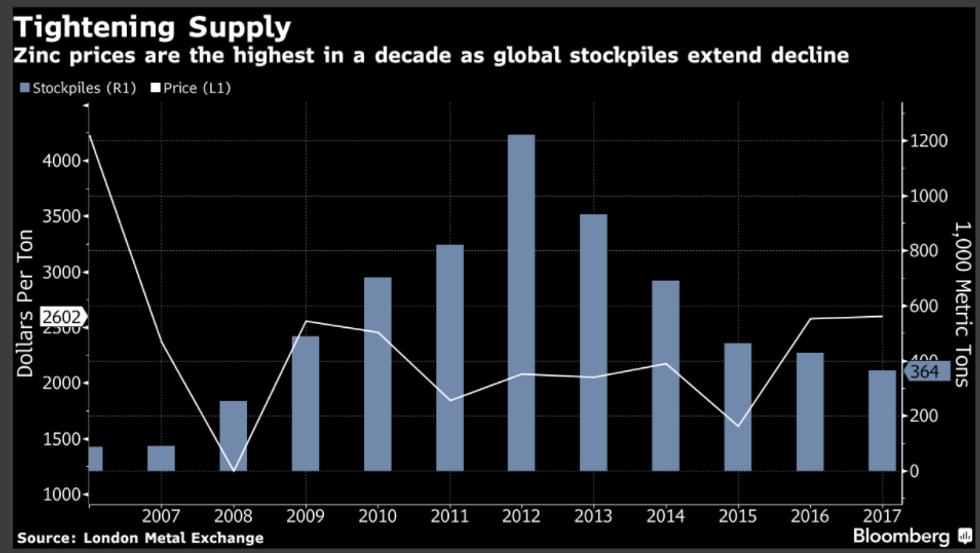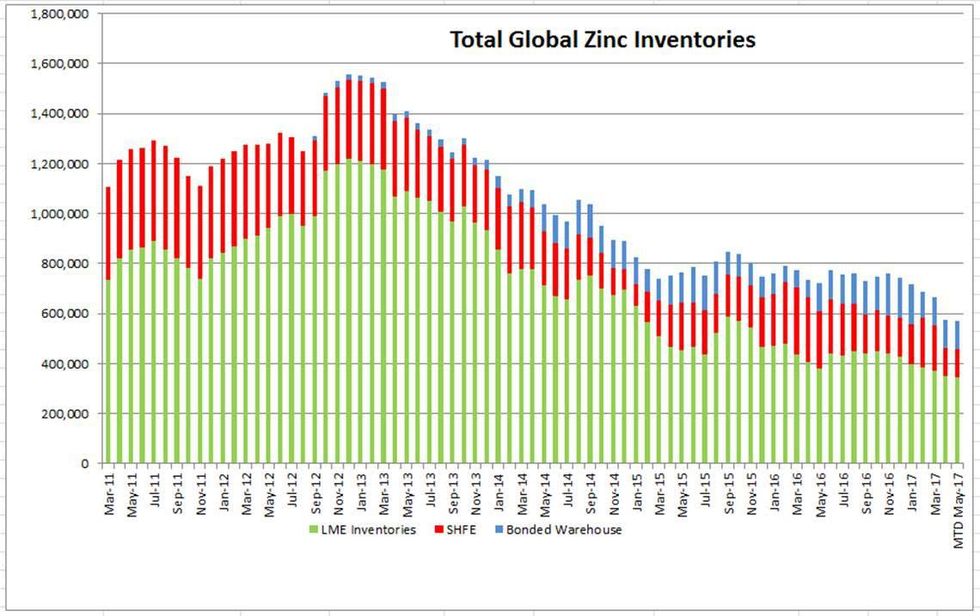
Here’s how much zinc inventories have fallen this year and what that means for prices.
Zinc prices have been under pressure so far this year. Slower demand from China, the world’s top consumer of the metal, and growing geopolitical tension have soured investor sentiment towards riskier commodities.
But even though zinc sank as low as $2,525 a tonne in April, analysts remain positive about its prospects in 2017. The zinc market is still in deficit, and LME inventories continue to shrink.
In fact, earlier in May, LME zinc inventories were at their lowest level since 2009, at 344,725 tonnes; they currently stand at 346,225 tonnes, down more than 19 percent year-to-date. Overall, LME zinc stockpiles have been declining since 2012 and in the last couple of years prices have been rising in tandem. They are now at about their highest level in a decade.
Keeping an eye on stockpile levels is important for zinc-focused investors, as they show how much zinc is readily available to end users. “Inventory [levels] can swing market balance and, to some extent, prices too,” CPM Group commodity analyst Yvonne Li explained via email.
Chart via Bloomberg.
LME zinc stocks make up most of the world’s zinc inventory, but zinc is held in other places as well. And as the chart below from Scotiabank shows, zinc inventories are falling elsewhere as well — total global zinc inventories are on a downtrend and are currently sitting at 561,000 tonnes. Li also noted that off-exchange inventories play an important role in influencing zinc prices.
Scotiabank says that total global zinc inventories now stand at just 14.3 days of consumption, down from over 19 days at the beginning of 2017. In 2006, when total global inventories moved below 10 days, zinc prices commenced a brisk move from under $1 per pound to $2.05. “We think the same big move could happen again,” analysts at the firm said.
Similarly, Wood Mackenzie zinc analyst Jonathan Leng expects to see acute tightness in the zinc market later this year, with stocks “projected to fall to historically low levels and remain so until 2020.” That will translate into a price next year that is “comparable to the 2006 price peak,” he believes.
Chart via Scotiabank.
That said, Li is not as optimistic, and expects LME and SHFE zinc inventories to rebound in the coming months as a result of rising supply and weaker demand. “With zinc prices still at multi-year highs, [higher zinc output from China] is expected to continue, which means the supply tightness we saw last year will ease gradually,” she said.
Other factors that could impact zinc prices this year include increasing demand from China and India. Currently the ILZSG is forecasting a zinc deficit of 226,000 tonnes in 2017, despite an expected increase in mine supply due largely to a recovery in India’s production.
According to panelists at FocusEconomics, the average zinc price forecast for 2017 is $2,753. The most bearish forecast for the year comes from Capital Economics, which is calling for a price of $2,450; meanwhile, BMO Capital Markets is the most bullish with a forecast of $3,147.
Don’t forget to follow us @INN_Resource for real-time news updates.
Securities Disclosure: I, Priscila Barrera, hold no direct investment interest in any company mentioned in this article.




